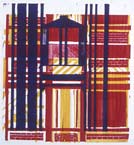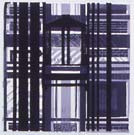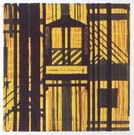Mary Stewart





Exploration of a variety of relief printing processes including woodcut, linocut and collograph. Lecture and studio.
Background
Relief printmaking is the oldest and most direct form of printmaking. By inking raised surfaces on wood, clay, metal, linoleum, plastic or cardboard, we can produce a wide variety of linear or tonal effects. Using multiple blocks, colors can be layered, creating a brilliant array of opaque or transparent images.
The first half of the course will be devoted to linocut and woodcut in black and in color, with particular emphasis on three color separation and layering. The next two weeks will be devoted to the constructed relief print, including collograph, collage and chine colle. A month-long group portfolio, devoted to The Power of Myth is planned from mid-March to mid-April. A final experimental project completes the term.
Every session will be packed with demonstrations, printing, and critiques. An average of five hours a week beyond class time will be needed for printing, drawing, and cutting blocks.
Lab fee will be used for a start-up kit of printing paper, blotters, wood and linoleum, plus solvents, inks, blankets and brayers. Expect to spend an additional $75.-$100. for personal equipment and supplies.
Basic Concerns
- Sensitivity to Materials. A linoleum block or collograph plate presents a unique drawing surface. An appreciation of its characteristics is an essential part of printmaking.
- Sensitivity to Process. Printmaking can be used to document the process by which an image evolves. This evolutionary image-making process can help reveal the special creative concerns of each artist.
- Color Experiments. Using the plate or block as a constant, printmaking becomes an ideal means of exploring color relationships.
- Application of Basic Drawing and Design Concepts. A solid understanding of drawing and design combined with good technique leads to good prints.
- Craft. Poorly torn edges, sloppy printing and other examples of poor craft detract from viewer appreciation of the image. Skillful use of tools and shop equipment, efficient use of press time and proper care of completed prints are among the requirements for this course.
- Safety. We will be using mineral spirits and alcohol when printing. Barrier cream and nitrile gloves will be used per Risk Management guidelines: USE THEM!
- Development of a Personal Vision. Even as a beginning printmaker, you are encouraged to appreciate and develop your own creative impulses. To provide necessary technical information, I follow a highly structured schedule during the first half of the course. Once these basics are mastered, you can move confidently into more personal work. An experimental approach will be emphasized: keep all trial proofs for use in collages.
Reserve Reading List
Relief Printmaking - Clemson
Collograph Printmaking -Wenninger
Structure of the Visual Book- Smith
Printmaking:History&Process - Saff & Sacilotto
Course Policies and Requirements
- Attendance. Due to the complex technical nature of printmaking, attendance is mandatory. There is no single course text, a substantial amount of work is done during class, and it is impossible to make up missed demonstrations. If you miss more than two class meetings, or arrive late more than four times, you should drop the class, as the resulting grade is often a C- or below.
- Maintenance. We all benefit from maintaining a clean, orderly shop. A final critique/shop cleaning day will occur during exam week.
- Grades.Two factors will be considered in the determination of grades. The quality of the product, including inventiveness, sensitivity to materials, compositional effectiveness, and craft, will count 55%.The quality of the leaning process, including risks taken, range of ideas explored, and contributions to class discussions, will count 45%.Two editions, twenty color experiements and a variety of experimental prints and collages are required for the term.
Course Structure
JAN 14: Introduction. Demo transfer and cutting; begin drawings.
Project 1: Visual alchemy I. Transformation of a familiar handheld object or an architectural site. Homework: complete a black and white 6x9" design using line and texture to define the interior & exterior of your subject. Transfer.
JAN 21: Cutting and hand printing line image, proof press demo, cutting and proofing state 1. homework: complete cutting black block; print edition of ten.
JAN 28: Critique of state 1. Discussion of curating; matting demo. Image transfer to block 2, 3, 4. Mat one print, plan color separations. homework: cut blocks 2 and 3.
Project 2, Visual Alchemy II: three color separation plus counterpoint.
FEB 4: Color printing demo; complete three color variations in class. homework: complete five more color variations.
FEB 11: Review color experiments. Blended printing demo; cut counterpoint block, proof. homework: four color variations, prep portfolio.
FEB 18: Group Crit and Individual Portfolio Reviews. Woodcut demo.
Project 3: Containment/Release. Design, cut and print a reductive woodcut image exploring conceptual and compositional containers.
FEB 25: Worktime for woodcut project. Individual Portfolio Reviews.
Project 4: Hide and Seek: The Constructed Print. Using collograph, collage, or colle complete a minimum of four 11x15" experiments, using multiple plates.
MAR 4: Demo constructed print. Finish woodcut and start collograph plates. homework: proof collographs; mix three colors.
MAR 18: Crit of woodcut and collographs. Power of Myth assignment introduced.
Project 5: The Power of Myth. Using any relief technique, complete an edition of 18 for an exchange portfolio. Prepare three studies and a one-papge brief proposal for Mar 25 class.
MAR 25: Discussion of Power of Myth; proposal due. Individual appointments. homework: complete 1/3 of the work for the assignment.
APR 1: Power of Myth Team Meetings; in-class worktime. Complete another 1/3 of work for the assignment.
APR 8: Complete Power of Myth assignment.
APR 15: Critique and Trade Power of Myth prints. Start final project.
Final Project: Any Unconventional and Experimental approach to Relief Printmaking: such as print collages, sculptural prints, books, or oversized prints.
APR 22: Final Project worktime and individual appointments.
APR 29: Final Project critique, shop clean-up and individual appointments.
Mary Stewart email address: marystewart3@gmail.com
